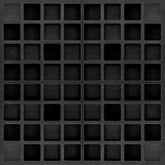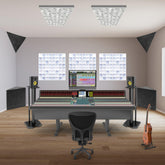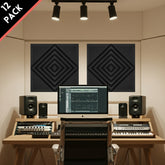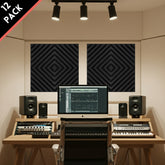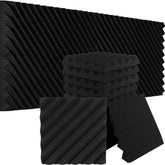Compression Deep Dive: Mastering Dynamics in Your Mix
Compression Deep Dive: Mastering Dynamics in Your Mix

Understanding Compression
What is Compression?
Compression reduces the dynamic range of an audio signal by attenuating the louder parts of the signal and bringing up the quieter parts. This helps to create a more consistent volume level, making the track easier to balance within the mix.
Key Parameters of Compression
- Threshold: The level above which compression starts to take effect. Signals below this level are unaffected.
- Ratio: Determines the amount of compression applied once the signal exceeds the threshold. For example, a ratio of 4:1 means that for every 4 dB above the threshold, the output will only increase by 1 dB.
- Attack: Controls how quickly the compressor responds after the signal exceeds the threshold. A fast attack captures transients, while a slow attack allows them to pass through.
- Release: Controls how quickly the compressor stops reducing the gain after the signal falls below the threshold. A fast release allows for more natural dynamics, while a slow release smooths out the signal.
- Makeup Gain: Boosts the overall output level after compression, compensating for any volume loss caused by the reduction in dynamic range.
Types of Compression
VCA Compression
How It Works: Voltage Controlled Amplifier (VCA) compressors use a solid-state circuit to control gain reduction. They are known for their fast and precise response, making them ideal for controlling transients and adding punch to drums and percussive elements.
Applications: Drums, percussion, bass, and any signal requiring tight, controlled compression.
Examples: DBX 160, SSL G-Series Bus Compressor.
Optical Compression
How It Works: Optical compressors use a light source and a photosensitive cell to control the gain reduction. They tend to have a smoother, more natural compression curve, making them ideal for vocals and melodic instruments.
Applications: Vocals, guitars, and other instruments that benefit from a gentle, musical compression.
Examples: LA-2A, Teletronix LA-2A.
FET Compression
How It Works: Field Effect Transistor (FET) compressors mimic the behavior of tube compressors but with solid-state components. They are known for their fast attack times and aggressive compression, which can add energy and excitement to a mix.
Applications: Drums, vocals, and other elements that need aggressive compression with character.
Examples: 1176, UA 1176LN.
Tube Compression
How It Works: Tube compressors use vacuum tubes to control gain reduction, adding warmth and harmonic distortion to the signal. They are often used for their coloration and smooth, vintage sound.
Applications: Vocals, bass, and other instruments that benefit from warmth and color.
Examples: Fairchild 670, Manley Variable MU.
Compression Techniques
Parallel Compression
What is Parallel Compression? Parallel compression, also known as New York compression, involves blending a heavily compressed signal with the uncompressed (or lightly compressed) original signal. This technique allows you to add punch and sustain without losing the natural dynamics of the original signal.
How to Use It: Send your audio track to an auxiliary channel, apply heavy compression to the auxiliary signal, and then blend it back with the original track to taste. This technique works well on drums, bass, and even vocals.
Sidechain Compression
What is Sidechain Compression? Sidechain compression uses an external signal to trigger the compression on the primary track. This technique is often used to create space for one element in the mix by ducking the volume of another.
How to Use It: A common application is ducking the bass whenever the kick drum hits, ensuring that both elements have their own space in the mix. Simply set the compressor on the bass track to be triggered by the kick drum signal.
Multiband Compression
What is Multiband Compression? Multiband compression allows you to apply compression selectively to different frequency bands within a signal. This technique is particularly useful for controlling complex signals like full mixes or mastering.
How to Use It: Use multiband compression to control low-end rumble, tame harsh high frequencies, or glue different elements together in a mix. It’s especially useful in mastering to balance the overall frequency spectrum.
Creative Uses of Compression
Adding Punch and Presence
Drums: Use a fast attack and release with a medium ratio to add punch to kick and snare drums. For parallel compression, blend in a heavily compressed version of the drum bus to add weight and impact.
Vocals: Apply gentle compression with a slower attack to enhance the presence of a vocal, making it sit forward in the mix without overpowering other elements.
Glueing a Mix Together
Mix Bus Compression: Applying gentle compression across the entire mix bus can help glue the mix together, adding cohesion and consistency. Use a low ratio (e.g., 2:1), a slow attack, and a medium release to subtly control dynamics without squashing the mix.
Enhancing Sustain
Guitars and Bass: Use compression to extend the sustain of guitar or bass notes. A slower attack and release, with a medium ratio, can help maintain the natural tone while increasing sustain.
Adding Character
Vintage Compression: Use tube or FET compressors to add warmth, coloration, and character to your tracks. These compressors introduce harmonic distortion that can enhance the richness and depth of your mix.

Avoiding Over-Compression
Recognizing Over-Compression
Over-compression occurs when the dynamics of a track are overly reduced, leading to a flat, lifeless sound. Signs of over-compression include a lack of dynamics, pumping effects, and an unnatural-sounding mix.
Tips to Avoid Over-Compression
- Use Compression Sparingly: Start with gentle settings and increase compression only as needed. Listen critically to ensure you’re enhancing the sound rather than squashing it.
- Check the Gain Reduction Meter: Keep an eye on the gain reduction meter to ensure you’re not applying too much compression. A reduction of 3-6 dB is often sufficient for most applications.
- A/B Testing: Regularly bypass the compressor to compare the compressed and uncompressed signal. This helps you hear the impact of the compression and decide if it’s improving the mix.
Conclusion
Compression is a powerful tool in the audio engineer’s arsenal, capable of shaping the dynamics and tone of a mix in profound ways. By understanding the different types of compressors, mastering various compression techniques, and knowing when to apply them creatively, you can elevate your mixes to a professional level. Remember, the key to effective compression is subtlety and careful listening—use it to enhance your mix, not overpower it.
ABOUT AUTHOR
House Live Engineer of Free Bird, a live house with the history of South Korea's indie music scene.
Single album/Regular album/Live recording, Mixing and Mastering experience of various rock and jazz musicians







